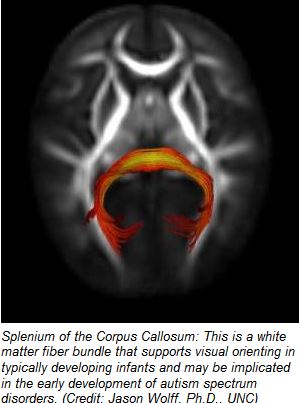Atypical Brain Circuits May Cause Slower Gaze Shifting in Infants Who Later Develop Autism
[Source: Science Daily]
 Infants at 7 months of age who go on to develop autism are slower to reorient their gaze and attention from one object to another when compared to 7-month-olds who do not develop autism, and this behavioral pattern is in part explained by atypical brain circuits.
Infants at 7 months of age who go on to develop autism are slower to reorient their gaze and attention from one object to another when compared to 7-month-olds who do not develop autism, and this behavioral pattern is in part explained by atypical brain circuits.
Those are the findings of a new study led by University of North Carolina School of Medicine researchers and published online March 20 by the American Journal of Psychiatry.
“These findings suggest that 7-month-olds who go on to develop autism show subtle, yet overt, behavioral differences prior to the emergence of the disorder. They also implicate a specific neural circuit, the splenium of the corpus callosum, which may not be functioning as it does in typically developing infants, who show more rapid orienting to visual stimuli,” said Jed T. Elison, PhD, first author of the study.
Elison worked on the study, conducted as part of the Infant Brain Imaging Study (IBIS) Network, for his doctoral dissertation at UNC. He now is a postdoctoral fellow at the California Institute of Technology. The study’s senior author is Joseph Piven, MD, professor of psychiatry, director of the Carolina Institute for Developmental Disabilities at UNC, and the principle investigator of the IBIS Network.
Read the Rest of this Article on Science Daily
PediaStaff is Hiring!
All JobsPediaStaff hires pediatric and school-based professionals nationwide for contract assignments of 2 to 12 months. We also help clinics, hospitals, schools, and home health agencies to find and hire these professionals directly. We work with Speech-Language Pathologists, Occupational and Physical Therapists, School Psychologists, and others in pediatric therapy and education.
